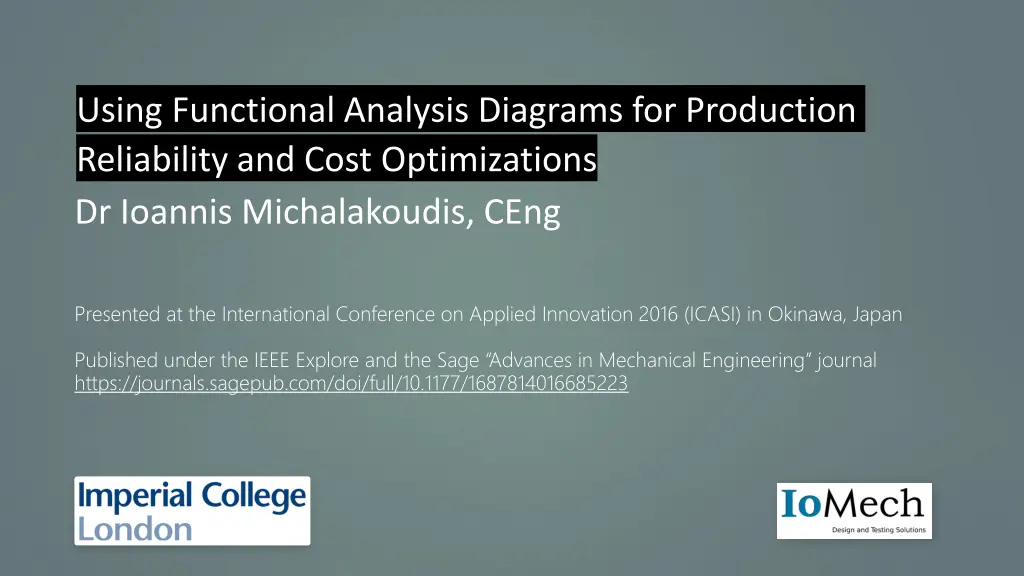
Functional Analysis for Production Reliability and Cost Optimization
Explore the use of Functional Analysis Diagrams and FMEA Approach in enhancing production reliability and cost optimization. Learn about Value Engineering to improve product efficiency. Check out the informative resources shared in this post.
Download Presentation

Please find below an Image/Link to download the presentation.
The content on the website is provided AS IS for your information and personal use only. It may not be sold, licensed, or shared on other websites without obtaining consent from the author. If you encounter any issues during the download, it is possible that the publisher has removed the file from their server.
You are allowed to download the files provided on this website for personal or commercial use, subject to the condition that they are used lawfully. All files are the property of their respective owners.
The content on the website is provided AS IS for your information and personal use only. It may not be sold, licensed, or shared on other websites without obtaining consent from the author.
E N D
Presentation Transcript
Using Functional Analysis Diagrams for Production Reliability and Cost Optimizations Dr Ioannis Michalakoudis, CEng Presented at the International Conference on Applied Innovation 2016 (ICASI) in Okinawa, Japan Published under the IEEE Explore and the Sage Advances in Mechanical Engineering journal https://journals.sagepub.com/doi/full/10.1177/1687814016685223
FMEA Approach Define application primary functions Identify their Potential Failure Modes Identify Failure Mode criticality (Define RPN) Re-design to reduce criticality Current Design Classification Severity Process Step/ Function Potential Failure Mode Potential Cause(s) of Failure RPN Occurence Requirement Potential Effect(s) of Failure Recommended Action Detection Controls Prevention Controls Detection Rod to Piston assembly Piston comes loose and disengages from rod Rod could shoot out of spring - highly dangerous - and cause serious injury 10 CC Wrong Riveting program chosen, wrong riveting tool or wrong staking tool Too much loctite - allowing it to get into spring training 2 visual 4 80 Retraining on use of loctite dispenser 8 training, loctite dispenser training, drawing training 2 visual 5 80 Retraining on use of loctite dispenser Piston must be properly fastened to Rod Loctite in spring Leak and/ or loss of performance smaller loss of performance (or scrap in house) 5 operator not taking care 3 visual (at test) none 5 SOP for piston assembly w/ pictures 112 ? Add note to check for bush seating? SOP? 75 Piston put on backwards 8 Bush not seated all the way in 2 7 Nose assembly Slow leak Spring fails to perform as required (will not extend) 8 Rod-seal - dirt under seal face visual 2 test 8 128 FOD (Cleanliness) Program. FMEA processes can be used for products or processes to identify and address any potential failure modes (ways in which the product or process may become dysfunctional or non-functional). 8 Rod-seal OD damaged while fitting into Nose Bearing visual 2 test 8 128 FOD (Cleanliness) Program. 8 SC Rod seal cut by sharp threads when passing over SC Damage to the external o- rings passing into tube visual 4 test 8 256 ? Rod seal must seal properly 8 visual 4 test 8 256 Tooling control - have bullet/ mask to fit over threads for protection 24 Tooling control - copy the Boeing Bam o-ring guide for all production 8 Errosion of external o-rings due to incompatible oil used drawing 1 test 3
Value Engineering Define application primary functions Analyse the functions of product components Use a Quality Function Deployment tool to evaluate each component function in relationship to the primary functions Value Engineering (VE) / Value Analysis (VA) is an interdisciplinary quantitative approach that focuses on improving the effectiveness and efficiency of the functions of a product, process, or organization.
FMEA / VE Issues Lack of cross-disciplinary communication and system s understanding Process complexity Cost of process Failure mode and effects analysis (FMEA) and value engineering (VE) currently equip the toolbox of many major quality management systems. Due to their cross-functional collaborative nature, both FMEA and VE processes are considerably resource-intensive, and for this reason, their use is often limited to large organizations.
FAD Hairdryer example The Functional Analysis Diagram (FAD) method is one of the Functional modelling methods available. The FAD model above illustrates the main elements of a hair-dryer system and their functional interactions. Studies indicate that FAD models can assist with communicating technical functions with cross disciplinary teams.
Proposed Methodology This methodology proposed the use of FAD models to assist with identifying the primary product functions for the first phase of both FMEA and VE processes.
Case Study FAD of a Gas Spring This above model was developed for conducting FMEA and VE at a UK- based manufacturing SME
Results - Qualitative Strongly Disagree Neither /Nor Strongly Agree Participant Survey Disagree Agree Assistance in identifying product functions 0% 0% 16.7% 66.7% 16.7% Process intuitiveness, appropriate for cross-functional teams 0% 0% 0% 0% 100% Efficiency in capturing both critical and non-critical components 0% 0% 0% 33.3% 66.7% Would you use it again in the future? 0% 0% 0% 50.0% 50.0%
Results - Quantitative 7% machining time reduction 10% quality cost reduction The results were compared with those of a traditional FMEA process conducted in the same organisation for a similar product 2 critical parts were captured and addressed 75% efficiency in comparison to standard FMEA processes conducted in the same organization
Conclusions The case study validated the methodology s feasibility claims The process yielded a 75% resource-efficiency improvement in comparison to FMEA alone





















